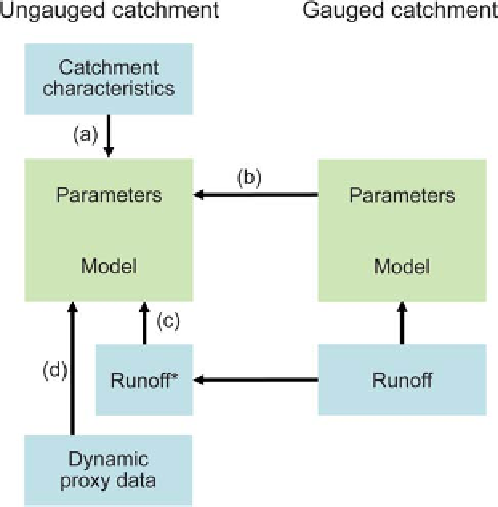Geography Reference
In-Depth Information
Soil hydraulic characteristics
Soil hydraulic characteristics, such as the saturated con-
ductivity, porosity and soil water release, are usually esti-
mated from infiltration experiments at the plot scale in the
field or, alternatively, from laboratory core tests. Important
characteristics estimated for the soil matrix (as opposed to
macropores) are the unsaturated hydraulic conductivity as
a function of saturation and the relationship between suc-
tion and saturation. In addition, measurements on the
dependence of the hydraulic parameters on freezing pro-
cesses may be necessary (Zhao et al.,
1997
; Gelfan,
2006
).
These characteristics can be directly used in the physics-
based models that are based on the Richards equation.
If only a few or no measurements are available, soil
hydraulic characteristics are usually estimated from rela-
tionships to soil texture (often defined by percentage sand,
silt, clay, organic matter, and perhaps bulk density). These
relationships are termed pedo-transfer functions (Wösten
et al.,
2001
). The appeal of pedo-transfer functions is that
soil texture data are now widely available in databases such
as the State Soil Geographic (STATSGO) and the Soil
Survey Geographic (SSURGO) databases in North Amer-
ica (USDA,
1991
; USDA NRCS,
1995
) and the European
soil database (Jamagne et al.,
2002
). The justification of
using pedo-transfer functions is that the grain size distribu-
tion (defined by the soil texture) should also be relevant to
the pore size distribution (which in turn is related to soil
hydraulic properties). Unfortunately, this is not often the
case because peds and cracks, rather than the grain size
distribution, tend to dominate the hydraulic properties.
It is therefore not uncommon for soil properties to vary
as much between soil types as within a soil type (e.g.,
Warrick et al.,
1990
) and for other influences such as
terrain to be important to soil hydraulic properties (Gessler
et al.,
1995
). This makes Wösten et al.(
2001
) conclude
that pedo-transfer functions are sufficiently accurate for
interpolation purposes between soil hydraulic measure-
ments in the catchment of interest, whereas they are not
recommended to be used in catchments where no measure-
ments are available. If no measurements are available,
it would seem that a minimum requirement for the use
of pedo-transfer functions would be that the catchment of
interest is hydrologically similar to those catchments in
which they were derived (see
Section 10.2
).
Figure 10.21
shows an example of the application of pedo-transfer func-
tions based on clay content to estimate saturated hydraulic
conductivity values, taken from the STATSGO data set.
The soil texture in the downstream parts of the catchment
indicates lower clay content than the upstream parts, which
is reflected in higher hydraulic conductivities estimated by
the pedo-transfer function.
While the soil physical parameters are, strictly speaking,
only applicable to physically based models based on the
Figure 10.20. Schematic representation of parameter estimation
approaches for predictions in ungauged basins. (a) A-priori
estimation of model parameters from catchment characteristics;
(b) transfer of calibrated model parameters from gauged
catchments; (c) constraining model parameters by regionalised runoff
characteristics*; (d) constraining model parameters by dynamic
proxy data.
10.4.3
A-priori
estimation of model parameters
Parameters of physics-based models are those that can be
observed in the field or estimated directly from measure-
ments of catchment or channel characteristics without the
use of runoff data. They possess a physical meaning
beyond the particular model used. Examples include
roughness parameters such as Manning
s n, hydraulic con-
ductivity, soil depth and surface albedo. Process-based
model parameters can be inferred from field measurements
or from remote sensing data. The former are usually local-
scale measurements and therefore best suited for small
catchments, while the latter are more appropriate for large
catchments. Often, parameters are inferred from qualitative
information or surrogates. Below, a brief summary is given
of three main categories of model parameters as used in
physics-based rainfall
'
runoff models and how they can be
related to surrogates more widely available than the model
parameters themselves, based on Blöschl (
2005a
). For the
case of conceptual and index models, the parameters
cannot be directly measured, but there are empirical rela-
tionships that have been found useful. A practical discus-
sion of some of the parameter estimation methods is given
in Duan et al.(
2001
) and Vieux (
2001
).
-

Search WWH ::

Custom Search